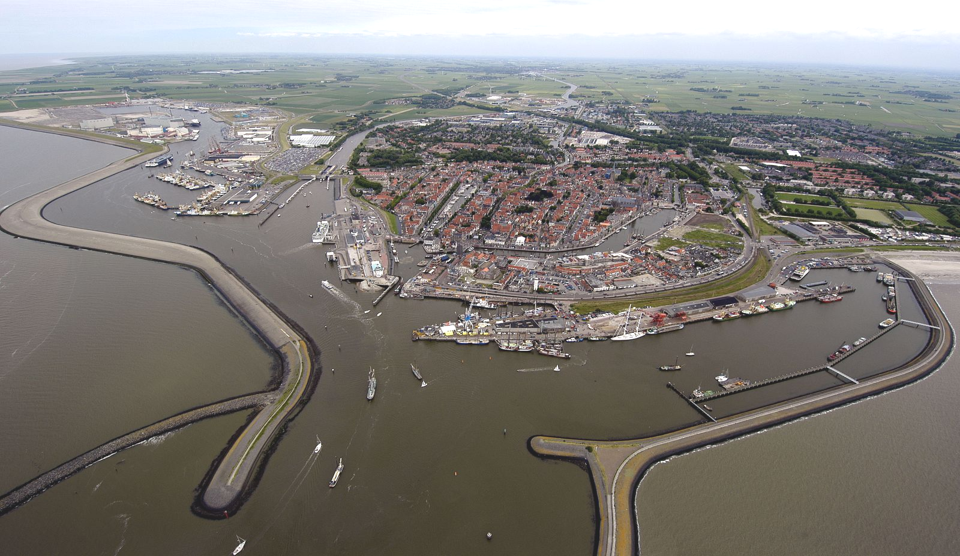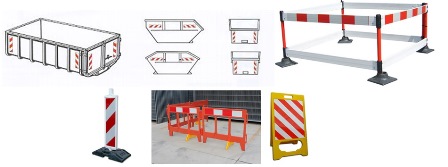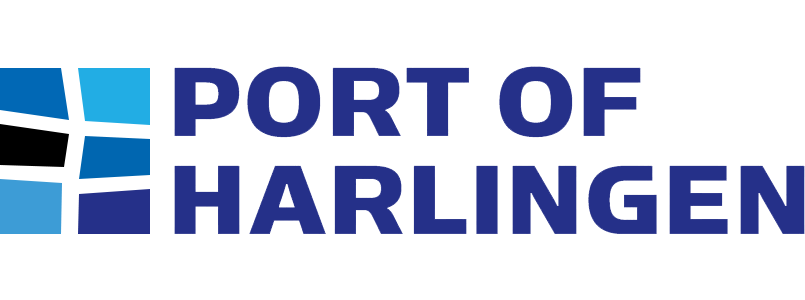The Inland Waterways Police Regulations (BPR) (Article 9.02 and appendix 13) stipulate that the maximum length is 140m and the maximum draught is 6m for the shipping lane from the sea to Harlingen. Rijkswaterstaat (the Dutch water management authority) may grant exemption for ships that exceed these dimensions, but this may be subject to conditions.

Rules and guidelines
Arrival and departure of seagoing vessels
No maximum sizes have been laid down in legislation and regulations for the ports of Harlingen. The Harbour Ordinance empowers the Harbour Master (mandated by the Ministry of Transport, Public Works and Water Management) to impose additional restrictions and measures with regard to the permitted dimensions, mandatory pilotage and tug assistance.
How does it work?
Categories
- 1 = seagoing vessels length overall up to 100m.
- 2 = seagoing vessels length overall 100 – 125m.
- 3 = seagoing vessels length overall >125m.
Category 1
No restrictive measures are imposed by Nautisch Beheer (Nautical Management). If the circumstances give reason to do so, the registered pilot contacts the duty Harbour Master. This decision or further measures are imposed.
Category 2
- Max. Wind force = 8 Beaufort
- Min. Visibility = 1500 metres
- Min. Tug capacity (min. 8 tons of Bollard Pull): with bow thruster = 1, without bow thruster = 2
- Additional measures/restrictions or exemptions by the duty Harbour Master after consultation with the registered pilot.
Category 3
a)
- Max. Wind force = 4 Beaufort
- Min. Visibility = 1500 metres
- with bow thruster = 2, without bow thruster = 3
b)
- Max. Wind force = 7 Beaufort
- Min. Visibility = 1500 metres
- Min. Tug capacity (min. 8 tons of Bollard Pull): with bow thruster = 3, without bow thruster = 4
Additional measures/restrictions or exemptions by the duty Harbour Master after consultation with the registered pilot.
Note: A bow thruster is defined as a bow thruster with sufficient power and thrust for the actual draught of the vessel.
More information
The main bottlenecks are found at
- the Vlieland ferry berth,
- fishing jetties 3, 8 and 31
- passage salt factory/Kloosterboer
- Construction location Damen Korte Lijnbaankade
For this reason there must be timely coordination between the registered pilot and the duty Harbour Master. The registered pilot can indicate which space he feels he requires. This takes into account the manoeuvring characteristics of the vessel and the expected hydrographic and meteorological conditions.
Ferry terminal:
If possible, the time of passage is adapted to the timetable. If this is not possible, consultation should take place with Doeksen and Rijkswaterstaat (the Directorate-General for Public Works and Water Management) to discuss an alternative berth for the ferry.
Fishing vessel harbour (Visserijhaven):
This is especially problematic between Friday morning and Monday morning. If timely notification is given, Nautisch Beheer can see to it that no cutters are double moored on jetties 3, 8 and 31. If a ship needs this space on arrival, Nautisch Beheer will take this into account until the ship has left again.
In short: as long as such a vessel is in port, there will be no double mooring on jetties 3, 8 and 31.
Other berths:
Depending on the first berth, it is established in consultation whether there could be any other bottlenecks, such as double moored ships on Industriekade, Zoutfabriek, Scheepswerf and Korte Lijnbaankade. This should also take into account any turning area.
Traffic control:
The duty Harbour Master at the Traffic Control Centre is authorised to give instructions to shipping traffic. Based on the traffic situation he will, if necessary, issue instructions to promote free passage and/or to prevent dangerous passage situations. If necessary, the registered pilot will provide information on the situation on the ground and may ask the Traffic Control Centre to take measures. However, the decision to do so remains in the hands of the duty Harbour Master.
Harbour barriers:
The registered pilot can request the Traffic Control Centre to block the harbour or part of it. The decision on this ultimately lies with the duty Harbour Master. He can also decide to block the port at his own discretion. Permission to continue sailing when parts of the harbour are blocked is granted exclusively by the Traffic Control Centre. The registered pilot refers other shipping to the Traffic Control Centre for permission.
Time port:
An Under Keel Clearance of 10% is operated. In consultation between the registered pilot and the duty Harbour Master this can be departed from if the characteristics of the ship and the route give reason to do so. An appropriate tidal current should also be chosen for this purpose. In general, the aim will be to pass the harbour entrance/outer harbour at slack tide. The cross current at the harbour and the effect of the ebb and flow current in the harbour must be taken into account.
For more information, please contact the Harlingen Port Authority:
- Telephone: +31 (0)517-723300
- E-mail: haven@portofharlingen.nl
- VHF 11
Registration procedures for North Sea fishery
Harlingen Port Authority is responsible for communication with the fishing fleet and the allocation of berths. This also applies to the jetties of Visveiling Urk (Urk’s fish auction).
Harlingen Port Authority
- Telephone: 0517-723300
- Email: haven@portofharlingen.nl
- VHF 11
How does it work?
North Sea cutters wishing to unload in Harlingen must submit a preliminary registration to the Port Authority.
Registration deadlines
| ETA | Register: |
|---|---|
| Before Friday 12.00 hours | Thursday 15.00 hours |
| Friday 12.00 – 18.00 hours | Friday 08.00 hours |
| After Friday 18.00 hours | Friday 12.00 hours |
What do we need to know?
- What time do you expect to put in to port (ETA)?
- Do you unload directly onto the truck or via the Visveiling (Fish Auction) (forklift truck)?
- Do you have any specific requirements regarding the use of the quay for repairs or maintenance?
- Are there any other issues that we should take into account in the berth planning? The berth plan will be drawn up or updated after the above-mentioned registration times.
We will inform you of the assigned birth as soon as possible. Please inform us of any changes as soon as possible!
Mandatory reporting of arrival and departure
Please report to the Port Authority using VHF channel 11:
- Before you enter harbour;
- Before you unmoor your vessel to move or turn it;
- Before you leave the berth.
Port waste plan
The Prevention of Pollution from Ships Act came into force in the Netherlands in 1986. This includes a ban on waste disposal for ships as well as an obligation for port managers to collect ships’ waste.
The port of Harlingen aims to be a sustainable port. As the port manager, Harlingen Port Authority has drawn up a plan that sets out how the waste from ships is collected and processed.
The Port Waste Plan was drawn up in close cooperation between the three Northern seaports: Groningen Seaports, Harlingen and Den Helder. Port users and regional authorities were also involved in the consultations. It is therefore clear to ships that regularly call at one or more of the Northern seaports how they can report their waste streams.
Port dues ordinances
Rules apply to all citizens, businesses and entrepreneurs. These rules, which are usually adopted by the municipal council, are also referred to as ordinances. All ordinances of our municipality are published on www.overheid.nl.
Harbour Ordinances
Specific ordinances have been adopted for all port-related matters.
Search for ordinances
You can visit the website of the government to search ordinances. Enter the letters of your postcode and/or search for a word or phrase that appears in the title or text of the ordinance.
If you only enter the letters of the postal code and then click on search, you will be shown all valid ordinances.
Compulsory Pilotage
Pilotage is compulsory for sailing across the Wadden Sea to the Port of Harlingen. Since 1 January 2021, new legislation and regulations have been in force to compulsory pilotage. You can read what this means for you in our information guide.
Marking of unlit obstacles
The public quays in the Harlingen port area are often freely accessible and designated as public roads. Parts of these quays are regularly used for the temporary storage of containers, materials, vehicles and cargo. This frequently causes dangerous situations and damage to passing vehicles.
In order to prevent this from happening, the Information and Technology Centre for Transport and Infrastructure (CROW) has drawn up a guideline: ‘Guideline for marking unlit obstacles – CROW 130’.
How does it work?
All property and goods stored on the quays, especially during the hours of darkness, must be clearly visible to road traffic. The best way to achieve this is of course to install good lighting, but that is not always practical or does not always have sufficient effect.
In such cases, these items must be marked in accordance with CROW guideline 130. This marking can be attached to the item or can take the form of separate marking fences/beacons around it.

The complete guideline can be ordered on the website www.crow.nl.
Waterway markings, special objects and vessels
Temporary mooring and protection poles in the port must be given lighting in accordance with certain guidelines. The lighting of moored ships must also comply with guidelines.
How does it work?
1. Lighting of temporary mooring and protection poles
Temporary poles (wood or steel tube poles) are regularly placed in Harlingen’s port to protect vulnerable ships or to provide better mooring options. These poles, in so far as they are placed in the waterway, are regarded as special markings under the IALA guidelines. Such marking must be carried out in accordance with IALA guidelines:
- Head signals (day shapes): Cylindrical yellow, possibly with a yellow horizontal cross.
- Lighting: Reflective yellow all around. It must not be possible to confuse the character with existing white lighting (e.g. cardinal marking).
Temporary facilities
- Poles that do not remain in place for more than one year are considered to be ‘temporary’. They are therefore not included in the Hydrographic Charts.
- The top 100cm of the pole must be yellow. The colour yellow must be in accordance with the usual waterway markings on the Wadden Sea.
- Poles must be equipped with an all-round yellow light. Minimum visibility at good visibility (>10 nautical miles) should be 3 nautical miles, calculated in accordance with IALA guidelines E-200. The character must be fixed (Fixed = F). At the request of Nautisch Beheer, the owner/manager of the pole must submit the specifications showing that the lighting meets these requirements.
- After installation, the client must provide Nautisch Beheer with the exact position of the poles in WGS-84 coordinates (to 3 decimal places).
Permanent facilities
- Poles that remain in place for longer than one year are treated as a permanent facility and are included in the Hydrographic Charts. For this purpose the client must provide Nautisch Beheer with the exact position of the poles in WGS-84 coordinates (to 3 decimal places)
- Poles that serve to mark the waterway take the form of lateral markings, with the corresponding colours and lighting.
- Poles that are part of a fixed mooring structure or are placed for the protection of engineering works are equipped with spotlights situated in or near the waterway. This lighting must not be dazzling or confusing for
- The top 100cm of permanent poles must be white.
2. Lighting of moored vessels in or near the waterway
The lighting of moored ships is covered by Article 3.20 of the BPR. The general rule is that moored vessels must be equipped with one or more white lights that are visible in all directions.
However, the article provides for a number of exceptions (paragraph 5), including:
- Berths with sufficient public lighting, where the ship is sufficiently visible
- Ships berthed in a safe place
- At berths or in waterways that have been designated as such by the Competent Authority.
The berths at the quays and jetties in the harbours are sufficiently lit and protected for through shipping, so that there is no need for lighting. However, there are two places in the port: the Blauwe Kop (KNRM station) and the Wachtsteiger Industriehaven, which are located directly on a busy shipping lane and have no or insufficient lighting. For safe navigation in the port, it is therefore better not to grant an exemption from the use of the prescribed lighting at these locations.
Directive
- Under Article 3.20 (5) of the BPR, berths can be designated where ships are not required to use lighting as provided for in Article 3.20 paragraphs 1 to 5.
- All berths in the seaport are thus designated, with the exception of the Blauwe Kop (quays used by the KNRM) and the Wachtsteiger Industriehaven.
More information
For more information, please contact the Harlingen Port Authority:
- Telephone: 0517-723300
- Email: haven@portofharlingen.nl
- VHF 11




